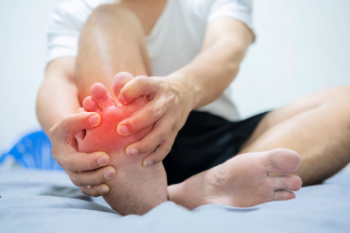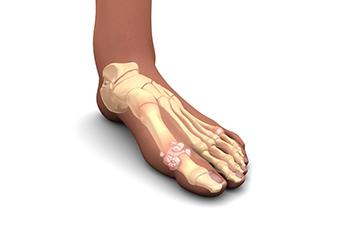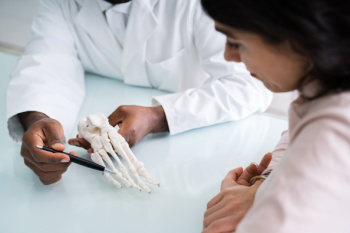Items filtered by date: August 2024
Falls Among the Elderly in Assisted Living Situations

Falls are a significant concern in assisted living facilities, particularly among the elderly. As people age, physical changes like muscle weakness, balance issues, and vision problems increase the likelihood of falls. Additionally, cognitive impairments, such as dementia, can lead to confusion and poor judgment, further raising the risk. Falls are prevalent in this population, often leading to serious physical injuries, such as fractures, and mental effects, like fear of falling, which can reduce mobility and independence. The environment in assisted living facilities, with unfamiliar layouts and communal living spaces, can also contribute to the risk of falls. Factors like wearing improper footwear, clutter, inadequate lighting, and lack of assistive devices play a role as well. If you or a loved one is living in an assisted living facility and have fallen and sustained a foot or ankle injury, or if you want to know more about preventing falls in this environment, it is suggested that you schedule regular appointments with a podiatrist for treatment and counsel.
Preventing falls among the elderly is very important. If you are older and have fallen or fear that you are prone to falling, consult with Mohammad R. Parsa, DPM from Madison Foot Clinic. our doctor will assess your condition and provide you with quality advice and care.
Every 11 seconds, an elderly American is being treated in an emergency room for a fall related injury. Falls are the leading cause of head and hip injuries for those 65 and older. Due to decreases in strength, balance, senses, and lack of awareness, elderly persons are very susceptible to falling. Thankfully, there are a number of things older persons can do to prevent falls.
How to Prevent Falls
Some effective methods that older persons can do to prevent falls include:
- Enrolling in strength and balance exercise program to increase balance and strength
- Periodically having your sight and hearing checked
- Discuss any medications you have with a doctor to see if it increases the risk of falling
- Clearing the house of falling hazards and installing devices like grab bars and railings
- Utilizing a walker or cane
- Wearing shoes that provide good support and cushioning
- Talking to family members about falling and increasing awareness
Falling can be a traumatic and embarrassing experience for elderly persons; this can make them less willing to leave the house, and less willing to talk to someone about their fears of falling. Doing such things, however, will increase the likelihood of tripping or losing one’s balance. Knowing the causes of falling and how to prevent them is the best way to mitigate the risk of serious injury.
If you have any questions, please feel free to contact our office located in Madison, MS . We offer the newest diagnostic and treatment technologies for all your foot care needs.
Common Causes of Joint Pain in the Big Toe

Joint pain in the big toe can be caused by several conditions. One of the most frequent causes is gout, a type of arthritis resulting from a buildup of uric acid crystals in the joint, leading to intense pain and swelling. Another common cause is bunions, where a bony bump forms at the base of the big toe, causing pain and misalignment. Arthritis, including osteoarthritis and rheumatoid arthritis, can also affect the big toe joint, causing stiffness and discomfort. Trauma or injuries, such as fractures or sprains, may contribute to joint pain as well. Identifying the underlying cause is vital for effective treatment, which may include medication, wearing proper footwear, and in some cases, surgical intervention. Pain in the big toe can cause difficulty in completing daily activities. If you have developed this type of pain, it is suggested that you consult with a podiatrist who can effectively diagnose and treat toe pain.
Toe pain can disrupt your daily activities. If you have any concerns, contact Mohammad R. Parsa, DPM of Madison Foot Clinic. our doctor can provide the care you need to keep you pain-free and on your feet.
What Causes Toe Pain?
Most severe toe pain is caused due to a sports injury, trauma from dropping something heavy on the toe, or bumping into something rigid. Other problems can develop over time for various reasons.
Toe pain can be caused by one or more ailments. The most common include:
- Trauma
- Sports injury
- Wearing shoes that are too tight
- Arthritis
- Gout
- Corns and calluses
- Hammertoe
- Bunions
- Blisters
- Ingrown toenails
- Sprains
- Fractures (broken bones)
- Dislocations
When to See a Podiatrist
- Severe pain
- Persistent pain that lasts more than a week
- Signs of infection
- Continued swelling
- Pain that prevents walking
Diagnosis
In many cases the cause of toe pain is obvious, but in others, a podiatrist may want to use more advanced methods to determine the problem. These can range from simple visual inspections and sensation tests to X-rays and MRI scans. Prior medical history, family medical history, and any recent physical traumatic events will all be taken into consideration for a proper diagnosis.
Treatment
Treatments for toe pain and injuries vary and may include shoe inserts, padding, taping, medicines, injections, and in some cases, surgery. If you believe that you have broken a toe, please see a podiatrist as soon as possible.
If you have any questions please feel free to contact our office located in Madison, MS . We offer the newest diagnostic tools and technology to treat your foot and ankle needs.
Heel Pain Can Be Treated!
Facts About Managing Gout

Managing gout attacks involves a combination of lifestyle changes and medical treatments to reduce uric acid levels and prevent flare-ups. Gout, once known as a disease of kings due to its association with rich foods and alcohol, is now widespread, affecting over eight million US adults. The rise in cases is also linked to obesity and high blood pressure. Gout is caused by uric acid crystals in the joints, leading to intense pain, redness and swelling, commonly in the big toe. Prevention strategies include losing weight, avoiding alcohol and high-purine foods like red meat and seafood, and incorporating low-fat dairy into your diet. Medications to lower uric acid levels are often necessary and regular use of them can significantly reduce the frequency and severity of gout attacks. These measures can improve the quality of life and prevent long-term joint damage. If you have symptoms of gout, it is suggested that you schedule an appointment with a podiatrist for help in managing it effectively.
Gout is a foot condition that requires certain treatment and care. If you are seeking treatment, contact Mohammad R. Parsa, DPM from Madison Foot Clinic. our doctor will treat your foot and ankle needs.
What Is Gout?
Gout is a type of arthritis caused by a buildup of uric acid in the bloodstream. It often develops in the foot, especially the big toe area, although it can manifest in other parts of the body as well. Gout can make walking and standing very painful and is especially common in diabetics and the obese.
People typically get gout because of a poor diet. Genetic predisposition is also a factor. The children of parents who have had gout frequently have a chance of developing it themselves.
Gout can easily be identified by redness and inflammation of the big toe and the surrounding areas of the foot. Other symptoms include extreme fatigue, joint pain, and running high fevers. Sometimes corticosteroid drugs can be prescribed to treat gout, but the best way to combat this disease is to get more exercise and eat a better diet.
If you have any questions please feel free to contact our office located in Madison, MS . We offer the newest diagnostic and treatment technologies for all your foot and ankle needs.
Reasons to Visit a Podiatrist

Foot, ankle, or toe pain can significantly impact your daily life, making even simple tasks challenging. For instance, runners often experience stress fractures or Achilles tendon pain, which a podiatrist can treat through diagnostic testing and appropriate treatment. Arthritis in the feet and ankles can cause swelling, stiffness, and pain, but a podiatrist can suggest treatments to maintain joint health and improve mobility. Diabetic patients should see a podiatrist regularly to manage foot health and prevent serious complications. Persistent heel pain, whether from heel spurs or plantar fasciitis, requires professional diagnosis and treatment to restore comfort and function. Ingrown toenails, if left untreated, can lead to painful infections that a podiatrist can effectively address. Injuries like sprains, strains, or fractures also necessitate a visit to a podiatrist for an accurate diagnosis. Conditions such as corns, calluses, bunions, and athlete’s foot can be managed with the expertise of a podiatrist, relieving pain and preventing further problems. If you are experiencing foot, ankle, or toe pain, it is suggested that you schedule an appointment with a podiatrist for an exam, diagnosis, and treatment options.
If you are experiencing pain in the feet or ankles, don’t join the stubborn majority refusing treatment. Feel free to contact Mohammad R. Parsa, DPM from Madison Foot Clinic. our doctor can provide the care you need to keep you pain-free and on your feet.
What Is a Podiatrist?
Someone would seek the care of a podiatrist if they have suffered a foot injury or have common foot ailments such as heal spurs, bunions, arch problems, deformities, ingrown toenails, corns, foot and ankle problems, etc.
Podiatric Treatment
A podiatrist will treat the problematic areas of the feet, ankle or lower leg by prescribing the following:
- Physical therapy
- Drugs
- Orthotic inserts or soles
- Surgery on lower extremity fractures
A common podiatric procedure a podiatrist will use is a scanner or force plate which will allow the podiatrist to know the designs of orthotics. Patients are then told to follow a series of tasks to complete the treatment. The computer will scan the foot a see which areas show weight distribution and pressure points. The podiatrist will read the analysis and then determine which treatment plans are available.
If you have any questions please feel free to contact our office located in Madison, MS . We offer the newest diagnostic and treatment technologies for all your foot and ankle needs.

